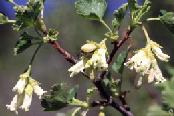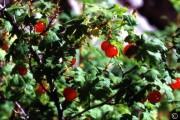

Wax Currant
Ribes cereum
Nutt.
It is a heavily-branched compact shrub about 3 to 5 feet.
Its clustered
spring-blooming flowers are creamy white to pale yellow, and about half an inch
long. The waxy, gray-green eaves are maple like, alternate. The
branches flare outward. The waxy, bright red berries
ripen in September.
Grows
best in full sun, on well-drained soils, with low water. It
is found in dry areas of middle to high elevations throughout the Great
Basin-Rocky Mountain region
Food uses.
The berries edible, although seedy and tasteless. Indians used them for pemmican,
explaining the name "squaw-berry." They might do as food in an
emergency. The Wax Currant is the most common species of
Ribes found in our area/. It grows at least as high as 9000
feet.
Medicinal Uses
Hopis use it to make a preparation for stomach ache.
Value for Wildlife:
Wax currant provides food and cover for wildlife. It is only fair to poor
browse for deer, but it is important on ranges where little else is available.
Chickadees and other birds consume the fruit of wax currant. (Source)
